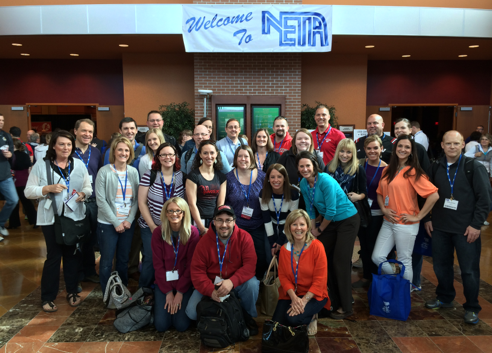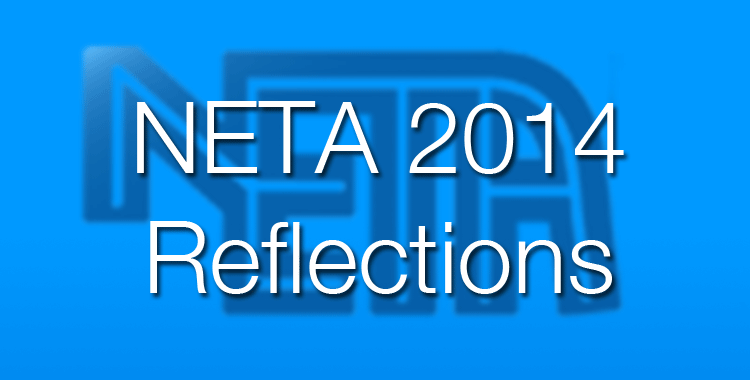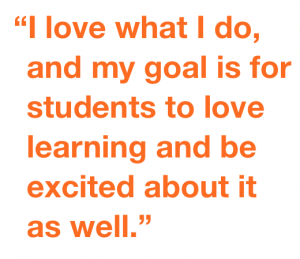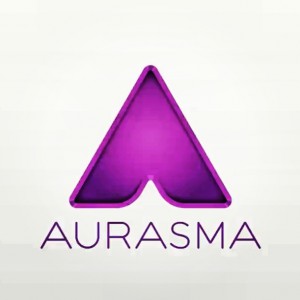One of my goals this year was to help people across the district share the great things they are doing with technology. If you haven’t had a chance to check out the ‘Close Encounters’ section on Area66 you should! Seeing what your peers do in their classroom is a great way to find new ideas for your own.
Sometimes though, it helps to widen the group you talk with. The NETA conference provides just such an opportunity. Held in Omaha, it features over 2,000 educators who share new and innovative uses of technology in the classroom. Going to the conference and getting ideas for one’s own class is only half of the value of attendance. The other half is coming back and sharing with others.
In that spirit, I’ve complied the ideas and reflections of several staff members into the attached PDF. Take a moment and skim through it. Read about how a 4 year old laughs 300 times a day, but the average 40 year old laughs only 4. Read about who to follow on Twitter. Read about new websites to try with your students. Read about how to integrate iPads into your curriculum. Read about much more too!
Elementary Reflections
Erica Riffner, Hillside:
Kahoot! No, I did not just sneeze. This site is exactly what I will be implementing next year when each student is handed their iPad. Kahoot is an easy-to-use, game-based classroom response system. Teachers can create their own quiz or pull up premade ones by subject/topic from the bank. The teacher projects their quiz while the students go to http://kahoot.it and type in the quiz code provided by the teacher. As the teacher goes through each question, the students tap their answers on the iPad. Instant feedback is provided to the teacher and each student. Results can be printed at the end, allowing teachers to know which students got it or which ones need reteaching. How cool would it be for your students to go from learners to leaders by creating their own Kahoot quizes?
Justin Presler, Westbrook Elementary
This year was my first experience going to the NETA conference and all I can say is WOW! Before going to the conference I felt like I new a lot about technology and did a decent job using it in my classroom, but wanted to be even better. After the conference I knew I was behind in implementing technology and knew I needed to make a change.
The NETA conference gave me a vision of what I want my classroom to be like next year and the years to follow. Not only using technology but also in how I teach. It made me want to focus more on the FUN of school again instead of just indicators and test scores. I walked away with countless ideas on how to implement technology and use it as a tool for lessons in my classroom.
One of my biggest take aways from NETA was, as a teacher you have to be willing to “LET GO” and that it is ok if you are not the expert on the App, iPad, or computer. Sometimes the students will know more and teach you and that’s OK.
There are not enough words to say how powerful the NETA conference has been. I learned so much in just two days! And with 1:1 iPads coming next year I cannot wait to try some of the new things I have learned with my students and for them to teach me some technology as well.
Melissa Misa, Swanson Elementary:
Since hearing one of the keynote speakers at the conference, there are several changes that I have implemented into my classroom that I can tell are making a difference already. The main message was about bringing joy back into the classroom, a topic about which I am very passionate. I love what I do, and my goal is for students to love learning and be excited about it as well. Two important factors to creating joy in the classroom come from 1) instilling a sense of awe or wonder in our students by noticing the world around us and 2) creating a classroom culture of gratitude. Since I wanted to have more than just good intentions, during break time I created a personal goal list of 8 things I wanted to do before the beginning of school next fall. I even came back Friday after the conference and began 2 of them right away. I created a list of “Awe-inspiring questions” and posted it on the wall. As we study science or have class discussions, I have found that there are many questions that there just aren’t answers for, but they can serve as great springboards for thinking or discussion. Some examples that I have posted already are things like “How will we ever discover more about black holes?” and “Is communication necessary for survival?” Eventually I would like to incorporate these questions into writing or journaling in some way. I have found that my students are actually pushing themselves to ask more “what if” questions because they want to have me post it on the wall!
I also put a large piece of paper on our door and wrote “Today I am grateful for…” at the top. Each day, my students write down one thing they are grateful for. Being grateful should not be limited to November or Thanksgiving, and I think it sets the tone for the rest of the day. The piece of paper quickly filled up as students were eager to write a variety of things.
Finally, one of the other things the keynote speaker shared is that our students should see us as learners as well. On Monday when my students came back, I wrote down my 8 personal goals/learnings, shared them with my students and posted them on my chalkboard as a reminder for myself. Here they are:
1. Create a Twitter account and follow really smart educators.
2. Have students regularly post what they are grateful for (in progress)
3. Think about one thing each day that amazes me, and have students do it too (in progress)
4. Think of ways that we can share the joy we experience in our classroom- and do them!
5. Use ipads for one lesson by the end of the year.
6. Learn how to play the ukelele and document my progress.
7. Plan how to incorporate personal learning projects next year.
8. Help my students identify and use their inner genius/gifts to contribute to our classroom and the world.
Molly McMeekin and Anne Guenther, Sunset Elementary
Going to NETA, we wanted to focus on how to better use the iPad for instruction. We found four main ideas.
iPads can be used during morning meeting times. A weather app is is helpful for looking at temperatures, finding differences between highs and lows, graphic temperatures and then for graphing the locations on a map.
Voice recording apps can be really helpful to help with students reading fluency. Apps such as iTalk can be used to record students reading allowing them to listen to themselves.
![]() Whiteboard apps can be incredibly powerful. Apps such as Explain Everything, Educreations and Skitch can be used to take a picture and have students draw on them. For example, students can take pictures of parallel lines in the room, label them and then share with other students. Additionally, students can use these whiteboard apps to record their own voice along with their actions helping to visualize learning.
Whiteboard apps can be incredibly powerful. Apps such as Explain Everything, Educreations and Skitch can be used to take a picture and have students draw on them. For example, students can take pictures of parallel lines in the room, label them and then share with other students. Additionally, students can use these whiteboard apps to record their own voice along with their actions helping to visualize learning.
 Haiku Deck: it’s more than just PowerPoint on the iPad. Haiku Deck can be used K-7 to let students easily create great looking presentations. It includes a gallery that searches Flikr Creative Commons, making it easy for students to find images. Instead of having students create a book report that only their teachers see, have them make a presentation and talk to the whole class!
Haiku Deck: it’s more than just PowerPoint on the iPad. Haiku Deck can be used K-7 to let students easily create great looking presentations. It includes a gallery that searches Flikr Creative Commons, making it easy for students to find images. Instead of having students create a book report that only their teachers see, have them make a presentation and talk to the whole class!
Lynn Spady, District EY
NETA is the highlight of my year! Some years I learn about a new piece of hardware or software application and other years it’s a list of new web tools to try. This year was different. It wasn’t so much about the tools and websites per se, but more about inspiration. Here are a few of my take-aways…
Take responsibility to own what you bring to the table. Everyone is a genius at something and if you sit back and wait or refuse to share, we ALL lose! We are better together and our impact multiplies when we share our genius with others. Look at the geniuses in your presence and tell them the world needs their contribution! Say this daily-there is no age limit! Check out Rediscovering the Genius in Each of Us (http://switchandshift.com/rediscovering-the-genius-in-each-of-us)
You can’t disrupt change incrementally! Think/dream audaciously, wonder boldly, take risks and expect to struggle, fail, and think deeply @AngelaMaiers
WWRT (What Went Right Today): Daily tweets from classrooms, schools, etc. Get more of our community on Twitter to capture the successes that happen throughout the day!
I think blogging is a great tool for classroom teachers, schools, teams, and students! If you know a K-2 teacher, share this blog and then encourage them to start their own: http://www.kindercrazeblog.com/?m=1@KleinErin Find other quality blogs at http://edublogawards.com/
Julie Schmitz, Oakdale
I heard Erin Klein speak and was inspired by her message, ‘encourage creativity.’ A question she asked, made me pause to reflect on my own teaching in the classroom, “DO YOUR RECOGNIZE CHILDREN FOR GETTING THE RIGHT ANSWER OR FOR ASKING A GREAT QUESTION?”
I have since started following her on twitter and checkout her website, Kleinspiration.com, on a regular basis. She also shared a very powerful video on bullying that a 4th grade student made. I showed this in my class meeting this week with my sixth grade students and they were very touched and inspired.
Daren Folchert, Hillside
During the 2014-2015 school year, Hillside Elementary created at technology newsletter called Tiger Tech. The latest Tiger Tech newsletter featured one take-away from the NETA conference. Tour Builder, a beta project by Google, uses Google Earth to pen locations accompanied with photos, videos, and descriptions. It can be great tool to use in Social Studies to tell the story of all the places studied during the year. In the Tiger Tech newsletter, Hillside shared how their students could use Tour Builder to tell the story of their summer vacation. They could showcase the places they visit, journal about their adventures, and share with friends and teachers.
Marlo Tomich, Swanson
“The only limitations come from ourselves, notice it, value it, expect it!” These are the words of Angela Maiers the keynote speaker from the NETA conference 2014. Having the opportunity to attend NETA was a wonderful experience. I was able to come back feeling renewed, rejuvenated, and ready to go! With the new 1 on 1 laptop initiative next school year 2014-2015, I was able to attend a breakout session that showed me how to organize and manage the technology to its fullest. With my passion for science I was able to attend a seminar on STEM, (Science, Technology, Engineering and Math). I was given different websites to use to deepen student learning and how the use of Lincoln Logs, Tinker Toys, and empty CD covers can help demonstrate to students that there is more than one solution to most given problems.
Secondary Reflections
Jon Allenmang, WMS
Graphite: https://www.graphite.org
Graphite is a website that helps you find the best apps, websites, games, and videos for you classroom. An independent company reviews the products and rates them. The also have a “teacher rating” which allows teachers to rate the material. Each product is rated in three areas; engagement, pedagogy and support. I have used Graphite to find engaging websites to enhance learning in my classroom and to find age appropriate, educational apps for my daughters iPad.
SafeShare.TV
SafeShare.TV is a website that allows you to show Youtube videos with out all the annoying adds, inappropriate comments, and other “related” videos off to the side. Youtube is a site I have always refused to use directly because of the unpredictability of the surrounding content. By copying the URL for the video and pasting it into this website you can avoid any inappropriate content while showing a Youtube video.
Stoodle (stoodle.ck12.org)
Stoodle is a website that provides students with a common place to share information. Much like Google Docs, but with out the need to remember a user name and password. It is a like a digital white board. Once a student has created a Stoodle they can share the URL and anyone who has that URL can post information to the Stoodle for all with that URL to see. I have let student uses this website to share research with group members while working on group projects.
Sarah Kroenke, WMS
When I go to a conference, I tend to gravitate toward meeting people I can stay in contact with throughout the year, so I can ask them more questions as I implement the different technology skills I learn in the sessions. Here’s a quick list of people that I find helpful to follow.
@Shareski – Dean Shareski- He’s a joyful Canadian who will inspire you to have more fun in the classroom. Day 2 NETA Keynote- Whatever Happened to Joy and Other Stuff that Really Matters
@michellek107 – Michelle Baldwin- previously taught elementary music and technology at Millard but moved to Colorado two or more years ago to teach in a charter/private school that has 1 to 1 for all elementary students (iPads, I’m pretty sure).
@Mrskmpeters – Kristina Peters- previously taught elementary in South Omaha. Now is working with technology at the State of Nebraska. She enjoys thinking things through and solving tech issues happily.
@BarbInNebraska– Barb Gilman- It seems everyone knows this great woman who teaches at St. Margaret Mary’s elementary school in Omaha. She is just a “NICE” person who communicates a lot about what her students are doing, but also about her personal interests (nature/writing) as well.
@lynnspady – LynnSpady- Um. . . You should know her, but if you don’t. . . She loves math, technology, middle schoolers, and much, much more. She likes trying new things with technology and “knows a lot about a lot of stuff.”
@j_allen– Josh Allen- Technology administration at Papillion-LaVista. He teaches a great class through Doane on social media and runs the Omaha EdCamp, which you should all attend. It’s FREE!
@ELanghorst– Eric Langhorst- Missouri teacher of the year, Google Certified Teacher, PBS Digital Innovator. Beyond all the awards, he’s a great guy from Howells, NE who loves tech and history.
Kim De la Cruz, WHS
I was impressed by a number of things at NETA. This year was the first year I have attended, and I was amazed at many strong presentations and presenters there were at the conference and pleased to see such an event locally. Because I was intrigued by the iBooks mini-presentation at the high school in April, I did make it a point to go to a couple of iBooks sessions while I was at NETA. I am excited to see how this application will be used next year and can really see it working in the classroom. I think it will be fun to experiment with it. I also attended a couple of sessions on either flipped classrooms or blended learning. It was interesting to learn about the different tools that are available to make this a reality in the classroom.
Kim Eymann, WHS
NETA 2014 Mission Possible
This was my first NETA experience, and glad to report it was a great experience. There were so many sessions that I would have liked to attend, but they did not all fit into my schedule so I had to choose very wisely. A couple of the sessions that I choose to attend dealt with Digital Citizenship. This really got me thinking about what do we do to for the students to prepare them to use technology appropriately and what can we do with students who don’t.
The session that I found most interesting and helpful was called “Preventing Digital Disasters with STOPiT.” Two Nebraska Educators have designed a monthly class for their students to attend if they have violated a technology rule, such as texting during class, not using school email appropriately, or even posting inappropriate things on the internet. They designed this class based on STOP class for traffic violations. Each month they have determined different topics to teach the students proper use of the computer (digital citizenship). I think this is a valuable way to teach and possibly reteach the importance of being a good digital citizen.
Jeanetter Kleppinger, WHS
Pechaflickr: http://pechaflickr.net : “Can you improv a coherent presentation from images you have never seen?” You choose the search topic and random pictures show up. Students then create a story or a synopsis of each picture. He demonstrated it with 4 teachers and as the picture changed he rotated the microphone.
Newsela: https://newsela.com Database of articles where the reading level can be adjusted based on the individual student. Appears the articles are updated often to include current events.
Knowmia https://www.knowmia.com A tool used when flipping a classroom, holds videos, tracks student progress, allows teachers to add “quiz” questions to check for understanding.
Carrie Turner, WHS
Using Augmented Reality with ESL and Striving Readers
Coral Hannah & Marsha Krabbenhoft
Aurasma is a free software program, which allows teachers to create videos that connect to lessons. The power of this lies in the fact that teachers can enrich lessons in ways that meet the needs of their particular students.
As an example, the presenter discussed certain lessons she had used with her students. During a history unit she was able to create “triggers” with certain pictures and phrases. Once the student was in the teacher’s Aurasma feed, he/she used an iPad and hovered the camera over the trigger. Once Aurasma recognized the image, it took the screen to a video created by the teacher or a website link. The video went into more depth about the picture or the text. For example, in a reading unit, the picture of the author of a story linked to more information about him.
In addition to enriching lessons in this way, she had students create their own videos and triggers. Once this was done, she set up a gallery of the trigger pictures, and students were able to view their classmate’s videos.
Aurasma is a simple program to use. Creating & uploading video is intuitive and creating the triggers that activate the videos is easy. I can see this program being used in a variety of classrooms including Math (a problem is the trigger, the accompanying video shows how to solve it or one like it), Science, World Languages, Social Studies… You get the idea! I think the only limit to this free program is our own imaginations!
Theresa Gosnell, WHS
What I was most impressed with was a keynote speaker, Dean Shareski. His topic, Is Joy Even a Thing?, made me think about certain questions and gave me ideas for some books to read in the future. One of the first quotes he shared was that the average 4 year old laughs 300 times a day, and the average 40 year old laughs 4 times a day. Here are some of the questions that made me think:
How often do your students get to wonder?
What are you learning right now, and do your students know about this?
How are your interests/passions infused into your classroom?
How are you spreading and sharing joyful moments in your school/classroom?
Whenís the last time you did something in which its primary purpose was to bring joy to you or your students?
How are you showing gratitude to your students? Parents? Colleagues?
Angela Bergman, WHS
The thing that most impressed me about the conference was that while it was technology based, the focus wasn’t all about technology. The key speakers were primarily about hope and getting the love of learning back into the classroom. The idea that making learning fun is a true NEED of our profession. It is valuable to have fun, and not just teach to the standards. Sometimes I feel like I have to justify what I’m doing if it is not exactly what I think I “should” be doing. Having fun is just as valuable as learning the letter of the standards, so I don’t need to justify it, I need to focus on engaging my students.
The other part that impressed me was how creative we can get, or have our students get, by using different apps together, or “smashing”. Using just one app goes only so far, but when you combine them, you multiply the power of their usage.



